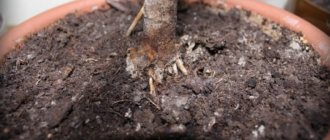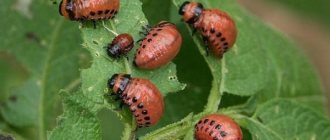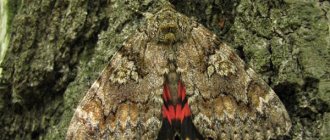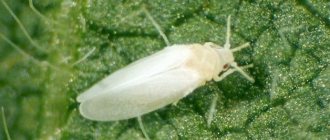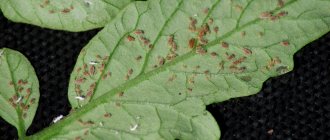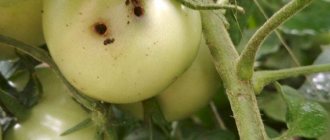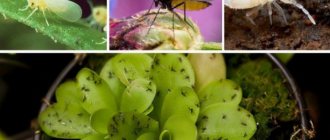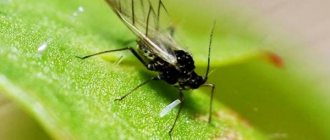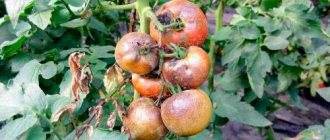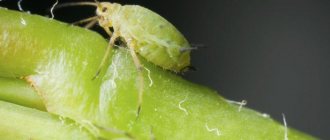Tomato beds often attract pests. The most dangerous of them is considered to be the whitefly - it sucks the juice of the plant, which leads to its drying out and death. Both adult moths and larvae are pests.
What to do if there are white midges on tomatoes, how to deal with them, and what measures can be taken to protect the crop from pests - you will learn all this from our article.
How to get rid of midges in tomatoes. How to treat tomatoes against midges
When fighting black midges, it is not enough to treat only adult individuals.
It must be remembered that the larvae hide in the soil, between the roots. To get rid of them and prevent the appearance of new flies, you need to treat not only the tomato bush, but also the soil in the circle around the trunk. To combat the larvae, “Bazudin” granules, the protection of which lasts about 6 weeks, or “Grom-2” are dropped into the top layer of soil around the plant. Its effect is longer - up to two months.
To distribute the granules evenly, they are mixed with coarse dry sand. The application dose per plant, or per 10 sq.m., is written on the packaging. Distribute at a depth of 2 cm, sprinkle with soil. The first time after application, the tomatoes are not watered.
To destroy flying individuals of fungus gnats and whiteflies, the same means are used.
The easiest way to combat midges is with systemic preparations that are absorbed by all parts of the plant. The impact on pests occurs when an insect lands on the leaves and begins to drink juice from them. It is effective even when some time has passed after spraying.
Systemic insecticides should not be used if there are less than 25-30 days left before harvest. Chemicals get into the fruits and do not decompose for a long time, and this is dangerous for humans.
In such cases, it is better to use enteric contact drugs: “Aktara”, “Decis-pro”. They are not phytotoxic to tomatoes and contain fast-acting substances.
Safer are products that contain substances of biological origin. For example, “Fitoverm” - tomatoes can be harvested two days after treatment, it is safe for the environment, and quickly decomposes in the soil.
When re-treating whiteflies, you should change insecticides, because these butterflies develop immunity to the same pesticides.
Treatment of tomatoes against midges is carried out in dry weather, in the morning or evening hours. Treatment in bright sunshine is not carried out for two reasons:
- causes leaf burn;
- the drug quickly evaporates from the surface of the leaf, without having time to affect the pest.
Briefly about tomatoes and their pests
Modern varieties are unpretentious and produce a rich harvest with minimal effort. But caring for a tomato requires knowledge and skills. Difficulties begin from the first days of growing seedlings. A little later, gardeners have another headache - how to get rid of pests and prevent diseases with the help of drugs or folk remedies.
Tomatoes belong to the nightshade family, which is loved by many insects and pathogenic bacteria . The latest are:
- Blackleg. First, the root collar becomes dark in color, then rots, which leads to thinning of the stem and death of the plant. The disease spreads quickly and can destroy a plantation in a short time.
- Late blight affects leaves and fruits, which dry out and rot. When infected, it can destroy 80% of all plants.
- Brown spotting appears when there is high humidity or low temperature. This is a fungal disease. The spores are easily transferred and can persist in the soil for a long time. Symptoms include brown spots on the undersides of leaves with a gray coating.
- Mosaic, which cannot be treated, is one of the most dangerous diseases of tomatoes. When infected, pigment spots are formed that resemble a mosaic. Next, the tomato leaves curl and wrinkle, and the bush withers before our eyes.
- Gray and brown rot , the appearance of which is promoted by coolness and humidity. A tomato is infected if first small and then large watery spots are noticed on the fruit.
As for pests, the most dangerous ones include:
- nematodes that damage roots;
- spider mite;
- scoop caterpillars that spoil the above-ground parts;
- sprout fly that attacks tomato seedlings. The eggs are in the ground, and with the heat, larvae appear, damaging the sprouts.
In addition, the Colorado potato beetle and aphids can spoil the tomato harvest.
Control methods in greenhouses and open ground
Insects have appeared on plants - what to do? Depending on their quantity and stage of infection, a chemical or a more gentle home remedy is selected than spraying the tomatoes.
Adult whiteflies do not cause much harm; the main danger comes from larvae and caterpillars. So if pests have appeared on the bushes in the open ground, but there are no caterpillars yet, this means that the plantings have not had time to suffer much.
Midges in open ground - what to do? You need to choose an insecticide that will not be washed off at the first rain and will not break down in direct sunlight. If pests appear in the greenhouse, how to fight them, you can use a more gentle preparation or fumigate them with insecticidal bombs.
If, when shaking the bush, a cloud of gray-white midges fly off the tomatoes, then the infection is very strong and it is necessary to use a powerful remedy.
The best effect is achieved by combining all possible control measures. On tomatoes and eggplants, parasites are destroyed by pesticides only before the ovaries appear. When the fruits are already ripening, you need to use biological and traditional methods.
Folk remedies for small flies
Soap
1 piece of laundry soap is crushed and beaten in warm water. The solution is sprayed onto the bushes or each plant is washed with a sponge, removing laid eggs of pests. You need to process several times until the insects disappear.
Garlic
A head of garlic is passed through a press and filled with about a liter of water. Let it sit overnight, filter, and spray the bushes.
Yarrow
The plants are treated with a decoction (1 kg of grass per bucket of water), and the lower leaves are washed with it using a sponge.
Agricultural technology
Agrotechnical measures include the timely destruction of tops and weeds on which the pest is capable of appearing. The greenhouse must be regularly ventilated, as the whitefly loves a warm and humid environment. The doors of the room should be opened at night, especially in cold weather: at temperatures less than +10, adult individuals die. They cannot be completely destroyed, but the number can be reduced.
Fumigation will also help. Smoke bombs with insecticides can be set on fire during the growth of bushes, and sulfur candles - only for prevention and in an empty greenhouse.
Biological and chemical preparations
Biological agents that are harmless to humans and plants are entomophagous insects. They eat insects. The most famous are the ladybug, the ichneumon beetle, the lacewing, and the praying mantis. They are bought in specialized stores and released onto the site.
Pheromone traps in the form of yellow boxes with a window, lubricated with a sticky substance inside, are effective. Parasites flock to the smell and are destroyed.
Of the insecticides, the most gentle is Fitoverm. It does not harm plants or the environment. Dilute according to the instructions, process several times, since the active substance is quickly destroyed.
Insecticides will also help:
- Fufanon,
- Aktara,
- Pegasus,
- Phosbecide,
- Confidor,
- Mospilan.
Usually two treatments are carried out several weeks apart. Spray the bushes with a spray bottle, choosing a dry day when there is no wind. After processing, the tomatoes should be in the shade. In a greenhouse, you can cover the roof with fabric.
It is recommended to change the insecticide even after a single application, because the parasite quickly develops resistance.
Features of the use of insecticides
It is necessary to fight insects on the leaves and larvae in the ground. For this it is better to use special chemicals. Insecticides are potent drugs. Safety precautions must be followed.
Types of funds:
- Aerosols. Sprayed in the habitats of flies, scare away and destroy them. Destroy cockroaches, ticks, flies.
- Solutions. Designed for spraying and watering the soil.
- Powders. They are laid in the ground and destroy the larvae.
Each group has its pros and cons.
Before using any drug, you must carefully study the instructions. Follow the dosage. You should not add more product, otherwise it will lead to the death of the seedlings.
The treatment is carried out in a non-residential area. You can go out onto the balcony or into the courtyard. A man puts on protective clothing, gloves, and a face mask. Animals, children, and other adults are removed from the room.
For treatment, it is better to use several products that are aimed at the soil and the plant itself. First the soil is processed, then the stems and leaves.
Repeated treatment is carried out after a week. The room is washed, ventilated, and hard-to-reach places are cleaned especially well.
Of the cheap and effective insecticides, Dichlorvos is often chosen. It is caustic and can burn plants. For processing you need to take a plastic bag. The product is carefully sprayed inside it. After which the bag is fixed over the seedling. It should not touch the leaves. Therefore, it is secured with a support in the ground or with the help of external objects.
The “greenhouse” is left for 10 hours, after which it is removed. This method effectively gets rid of larvae and adults.
How to determine the presence of this parasite?
You are a wonderful owner, the soil in the beds is loose and moist. So why do your tomatoes look so sad? Most likely they were attacked by aphids. Colonies of black midges occupy the tops of young shoots and actively colonize the underside of leaf blades. Ants scurrying around tomato bushes can be a harbinger of an aphid attack. After all, aphids are literally a delicacy for ants. In order to obtain a sugar-containing waste product - honeydew, ants carry aphids to new pastures - young plant leaves, protecting them from predators.
When changing their place of residence, ant families always take aphids with them so as not to be deprived of an uninterrupted source of sugars. And of course, they colonize plants near the anthill. Aphids reproduce very quickly; in a month, one midge produces several hundred thousand new individuals. Among them there are winged ones that fly long distances. Aphids feed on plant juices, piercing the surface of leaves and young shoots with their proboscis. They can completely destroy a young plant. A more mature plant slows down its growth, the leaves curl, the fruits become smaller, and ovaries do not form in place of the eaten flowers. Aphids not only deprive the plant of vital juices, but also infect it with viral diseases.
What is the danger of whitefly
The reason for the death of plants is the exceptional gluttony of the parasitic butterfly; its “appetite” significantly exceeds the need for nutrition. Subsequently, it begins to secrete “dew,” a kind of secretion that, settling on the leaves of tomato and cucumber, forms a sooty coating (fungus).
It blocks the pores of plants, preventing air exchange and photosynthesis. A black, sticky crust appears on the leaves, then they die.
Additionally, the whitefly spreads a lot of diseases, so the fight against it is long-term, complex, using various pesticides.
Damage from black midges
Small black midges can have transparent wings or without them: both subspecies pose a danger to the future tomato harvest. Pests multiply quickly. They settle throughout the tomato bush, sucking the juices out of the plant. They move to neighboring bushes and infest the garden. Damaged bushes die. If you do not take measures to destroy insects, you may lose your harvest.
Prudent gardeners organize preventive measures to prevent black midges from reaching seedlings or adult tomatoes. Plant fragrant herbs next to the tomatoes that attract insects dangerous to the parasite:
- os;
- lacewing;
- hover flies;
- ladybugs.
In addition to fragrant herbs, onions, garlic, calendula, and dill are planted. The midge does not like the smell of these plants. Eliminate weeds thoroughly: the parasitic insect feeds on tomato juice and likes to settle on weed shoots.
Get rid of anthills on the site. Ants protect aphids by feeding on the sweet secretions they secrete.
Preventative measures have not helped, and black midges are covering more and more bushes? Start exterminating the parasites immediately!
Types and signs of parasitism
Small insects can cause irreparable damage to crops both outdoors and in the greenhouse. You should inspect the plants daily, paying especially close attention to young seedlings, which quickly die when attacked by midges of any variety.
On tomatoes, two similar species are most often found - white aphids and black aphids. They differ in color and body structure, but they cause equally strong damage. To determine the infestation and take action in time, the easiest way is to shake the tomato bush, then the midge will fly into the air.
White midges whiteflies
On the bottom of the leaf it is easy to notice small white flies - these are whiteflies. They have transparent wings, the body is less than 3 mm. These insects jump and fly well, so they quickly infect plantings.
Most often this pest appears in greenhouses, although it is also found in open plantings. Like other types of aphids, the whitefly sucks the juices from the plant, resulting in curling of the leaves, drying out of individual parts, falling flowers, or the absence of ovaries on tomatoes altogether. In addition, black or brown spots appear.
Black
Black midges on tomatoes are common and multiply incredibly quickly. Tomato aphids are a little different, as there are many varieties. Regardless of the presence of wings or size, the insect quickly destroys the plantings and the plants die.
Dark midges are much smaller, their body grows no more than 2 mm in length, and up to 5 generations of insects are born in one season. Aphids lay eggs for the winter in old bark, foliage, and other secluded places. At the same time, they are not afraid of frost. In the spring, larvae hatch from the clutch, develop quickly, and reproduce without fertilization at high speed.
Where does whitefly come from on tomatoes?
Experienced gardeners who grow tomatoes in the garden or in a greenhouse know how important it is to carefully inspect the bushes of the plant during the season. Be prepared that during the inspection, whiteflies will be found on the foliage and stems.
This butterfly got its name because of the white, almost transparent color of its wings. It is small, about 3 mm in length. A fine powdery coating can be seen on the white wings. The harm from such a small fly is that it draws all the juices from the plant (the juices are its food). The leaves of the affected crop turn pale and soon completely lose color. The plant dies completely.
The first inspection of the crop should be carried out 10-12 days after planting the seedlings.
White butterflies appear on plants in warm summer time
It is important that there is a lot of precipitation, because for this aphid, warmth and moisture are optimal living conditions. If the air temperature drops to +10ºС and below, then adult butterflies die
It should be noted that their eggs do not suffer from low temperatures and tolerate even severe frosts well. During a season, one female can lay about 250 of them.
The whitefly thrives in greenhouses and greenhouses. “Resort” conditions for it are considered to be a humid air temperature of +20-+22ºС, dense planting of crops in a greenhouse or in open ground. That is why it is necessary to ventilate greenhouses so that the air does not stagnate.
Important! The breeding ground for whiteflies can be contaminated soil that gets onto the site or into the greenhouse along with the seedlings, and the seedlings themselves. The larvae can appear in the remains of leaves and tops of plants that have not been harvested since autumn.
Preventive measures
Despite the many methods of controlling the pest, it is still better to simply prevent it from appearing on tomatoes.
To do this, you should adhere to the following preventive measures:
- Prevent the appearance of dwarf, nettle, and woodlice in the garden plot . These plants attract whiteflies.
- Monitor the air temperature in the greenhouse . The optimal option is +15ºС. Higher temperatures become a favorable environment for insect life.
- Ventilate the greenhouse in a timely manner to avoid increasing air humidity.
- When planting tomatoes, maintain the required distance between seedlings to avoid thickening. So, only 4 seedlings can be planted per 1 m² according to the scheme: 50 x 50 or 70 x 30.
- Carry out pinching of plants in a timely manner .
- When purchasing seedlings, they must be carefully considered : larvae may be hiding under the leaves.
- Preparing a garden plot for planting tomatoes should begin in the fall : the soil is cleared of tops and fallen leaves, and the soil is loosened.
- The greenhouse in which the tomatoes will be planted must be well frozen in winter : it must be opened when the air temperature drops below -10°C (-15ºС).
- Aphids can grow on indoor flowers and only then move to seedlings if you grow them on windowsills yourself.
- Before planting tomatoes in the greenhouse, thoroughly disinfect it (use disinfectants - potassium permanganate, copper sulfate) and paint the structural parts. The pest can hide in greenhouse cracks. Make sure that the room is well ventilated.
- Do not fertilize the soil with compost.
We advise you to find out how to get rid of aphids on tomatoes.
Prevention of occurrence
It is best to carry out preventive measures in the greenhouse in advance to reduce or completely prevent the appearance of moths.
- Compliance with the planting scheme. Tomatoes should not be planted too close to each other in a greenhouse. For example, if these are tall varieties, then they are planted no more than 2-3 per square meter.
- Before starting sowing work, you need to remove all last year’s grass from the site, clean and dig up the soil in the greenhouse. These measures will remove insects that have overwintered there.
- After harvesting and cleaning the plot in the fall, you need to take all the compost and remaining manure out of the garden. The pest will certainly remain in these heaps for the winter, and in the spring it will enter the greenhouse.
- Ventilation of the greenhouse. During the growing process, the greenhouse must be thoroughly ventilated. And in winter, when there is frost, open it for a day so that it freezes, and with it the remaining larvae.
By following preventive measures, you can reduce the number of pests and the likelihood of their occurrence in the greenhouse. And if whiteflies do appear in the greenhouse, timely control measures will prevent them from harming the tomatoes.
83
How to prevent re-infection?
To prevent re-infection, it is necessary to carry out preventive work in the spring and autumn.
- Provide an alkaline soil environment by adding ash and slaked lime.
- Clean the greenhouses and fumigate them with tobacco smoke.
- In winter, it is necessary to freeze the greenhouse.
- Do not leave weeds, garbage, or waste on the site over the winter.
- Paint fences, trim and whitewash trees.
In conclusion, to summarize, if you follow the conditions for keeping areas and greenhouses clean, monitor the condition of the seedlings, and carry out preventive work on time, then not a single pest will be afraid, especially the whitefly.
How to fight whiteflies on tomatoes: what to poison and how to process tomatoes in a greenhouse, read more in this article.
Methods of disposal
If whiteflies appear on tomato bushes or adjacent plants in a greenhouse, you should immediately use the following means and methods of protection:
Fumigation in a greenhouse. This procedure should be carried out at least twice a year. The best option is to use sulfur candles in the absence of plants. When carrying out fumigation of growing vegetable crops, it is advisable to use bombs with approved insecticides, which are harmful not only to adult insects, but also to larvae.
Use of chemicals. Chemical controls must be used according to the instructions provided. The most widely used are “Confidor”, “Pegasus”, “Fosbecid”, “Aktellik”, “Fufanon” and “Mospilan”. You can use a systemic type of insecticide that penetrates plant juices and, when pests feed on them, causes the death of whiteflies. A good result is achieved by using contact insecticides that affect the parasite as a result of direct contact. However, if colonies of plant parasites are numerous, and the pest has become widespread, it is necessary to use soap-based products or aggressive chemicals.
Biological agents are an alternative option for destroying greenhouse whiteflies. A reliable and effective remedy is the use of special insects, the larvae of which parasitize the greenhouse whitefly and destroy this pest.
Folk remedies. Taking into account the biological characteristics of the pest, it is allowed to briefly lower the air temperature in the greenhouse, as well as use glue traps or traditional adhesive tape for flies. In addition, spraying plants with yarrow infusion, a solution of laundry soap with pepper, and garlic tincture has very good results.
What to do if there are midges in the seedlings
So, when you notice midges on seedlings, try to get rid of them as quickly as possible, using various methods. Sometimes you have to use several methods at once when the number of insects is quite large. But in any case, the very first thing to do is dry the top layer of soil. To do this, take the containers to a sunny, warm place and do not water the seedlings for several days. If there are not many midges on the seedlings yet, try using folk remedies.
How to kill midges - folk methods
There are many traditional methods; you can choose one, or combine two or three methods.
other methods
Insecticides against midges on seedlings
If the situation with midges has already progressed to such an extent that it cannot be corrected with the help of folk remedies, you will have to resort to stronger means and use potent insecticides. Just remember to ventilate the room well after treatment.
Means for treating midges on seedlings:
When using chemicals, read the instructions before use; some products will require re-treatment.
Fumigators
When there are a lot of seedlings and there is no way to quickly process them, fumigators with volatile preparations will come to the rescue. The principle of their operation is simple. The device is plugged into the electrical network. The plates or liquid that are installed inside the device heat up. When they evaporate, they release an insecticide that has a detrimental effect on all types of insects.
When using the plates, they are changed every 10-12 hours. Replacing them is easy; you just need to remove the used plate from the special connector and insert another one.
Fumigators, into which a bottle of liquid is inserted, allow you to use the device for several days without losing its insecticidal effect.
Getting rid of midges
Under the influence of aphids, the leaves first curl, then turn yellow and fall off.
- In greenhouse tomatoes attacked by aphids, the leaves curl and turn yellow, and growth stops.
- The plant gradually withers, losing vitality.
- Many ants may appear around the bush.
Many gardeners plant marigolds in the greenhouse to repel pests.
Folk remedies
- Soap and herbal infusions. A strong herbal infusion (wormwood, garlic, celandine) about 2-3 tablespoons is added to the soap solution (50 grams of soap per bucket of water) and sprayed on the bush.
- Soap-ash solution. Add a glass of wood ash to the soap solution (1/6 piece of laundry soap per bucket of water).
An ash-soap solution helps against whiteflies, as well as aphids and mites.
- Soda solution. Dissolve 3 whole tablespoons of soda in a bucket of water.
Chemicals
Chemicals are many times more effective, but more harmful to humans.
All chemicals can be used before bud formation; some drugs can accumulate in fruits and, if not used in a timely manner, can be harmful to human health.
Various insecticides and preparations are used against aphids: Karbofos, Aktara, Inta-vir, Iskra Zolotaya, Agravertin, Rovikurt, Confidor, Biotlin, etc.
How I used the drug
The first way to fight is to fight the larvae.
I make a solution: 1.5 g of Aktara needs to be diluted in 10 liters of water. I poured it under the root 3 times with an interval of 5 days.
The second way to fight is to exterminate black midges on seedlings.
To defeat midges that fly around seedlings or flower pots, you need to dilute 1 g of “Aktara” in 1 liter of water and spray the crops.
If you spray, it is better to carry out the procedure either on a ventilated balcony or outside.
I would like to draw your attention to what kind of “Aktor” I use.
The photo below is the drug that I used. This is AKTARA, VDG from Syngenta.
What kind of midges eat tomatoes?
Two species of midges colonize tomatoes. Some are black, they scurry, jump or fly from one plant to another. The second midges are white. The main part of them is hidden on the underside of the leaf, and flies into the air if you shake the plant.
Black midge
Another name for black midge is fungus gnat, tomato gnat or soil fly. The size of the body is 3-4 mm. Reproduction occurs in moist soil, on semi-decomposed organic remains. They like to lay eggs in places where fertilizer is applied in the form of an infusion of bird droppings or mullein.
The eggs are translucent and whitish in color. The larvae are worms from 3 to 8 mm long. Their body is white and their head is black. They live until pupation in the upper layer of soil. They pupate in the roots.
The larvae cause significant damage - they gnaw off the main part of the roots. If there are few pests, then the consequences of the damage are not noticeable: others quickly grow to replace the eaten roots. If conditions are favorable, midge reproduction increases and the damage becomes significant. The plant looks depressed, is stunted, and fruits are not produced.
In hot, dry weather, adults damage the growing point of tomatoes. Bacteria are often transferred from infected plants to healthy ones.
White midge
White midges are miniature whitefly butterflies. Their body size does not exceed 3 mm. The wings seem to be powdered with white dust. Eggs are laid on the underside of the leaf. The larvae are mobile at first, then they stick to one place and stay there until they transform into new butterflies.
Both midges and their larvae suck nutrients from the leaves. The upper surface of the leaves becomes covered with white dust, then turns black. The leaves dry out, the fruits also become covered with plaque and spoil.
If the temperature drops below 10°C, the life of whitefly butterflies stops. But low temperatures do not harm the eggs; their development cycle simply slows down. When the temperature rises, new butterflies will emerge from the larvae and repeat their life path.
The larvae overwinter on the remains of leaves in the top layer of soil.
Signs of infection
It is easy to recognize plant damage by the following external signs:
- yellowing and curling of leaves;
- uneven ripening of fruits;
- discoloration of the internal tissues of tomatoes;
- formation of plaque on the upper leaves;
- presence of insects on the inside of the leaf;
- when you touch the plant, a cloud of midges rises.
What kind of pests could these be?
Many insects can parasitize nightshades. There are two types of midges living on tomatoes: some pests are black in color and are constantly on the move, not inhabiting the plant. Other midges are white and settle on the leaves of seedlings.
The most dangerous pest is the greenhouse whitefly. Her body size is 3 mm. The insect prefers to inhabit the inside of the lower leaves of seedlings, where it lays eggs.
Whiteflies carry viral diseases - leaf curl, chlorosis and jaundice. If measures are not taken in time, this may affect the growth, flowering of the plant, its leaves and fruits.
The moths themselves are not so dangerous - they can be easily eliminated using folk or chemical means. However, it is not so easy to deal with insect larvae - they have protection in the form of a special coating, which reduces the effectiveness of the drugs. In addition, if you use the same products, insects can develop immunity to them.
What harm can they do?
White midges are the most dangerous pests of nightshades. Despite their small size, the damage they cause can be colossal. As soon as midges or their larvae attach to the plant, they begin to consume its sap. Because of this, the seedlings begin to experience a lack of nutrients, which affects their fruits. As a result, the green mass of the plant dries out and falls off, and the fruits wrinkle.
The vital activity of small midges leads to the formation of plaque on the top of the leaf, which can cause it to curl. At first it has a transparent color, which later turns black, indicating the formation of sooty fungi. Parasites appear from insect secretions. They cover the plant stem and fruits.
In what ways can I get rid of it?
Considering the diversity (more than 4000) of aphid species, their unpretentiousness and extreme fertility, we must start with preventive measures:
- Since the aphid larva prefers fruit trees and shrubs for wintering, timely removal of old exfoliated bark and young growth, whitewashing with lime, and the use of ant traps are measures that can reduce the population of these insects.
- Fighting ants that have settled in the beds.
- The smell of garlic and onions repels aphids; it would be nice to dilute the tomato rows with them. Finally, plant marigolds. The smell of these unpretentious flowers is unbearable for aphids, but extremely attractive to its worst enemy - the ladybug.
- After harvesting, all plant debris from infected beds should be carefully removed and burned.
- The right green manure will also help clear the garden bed of aphids. It's all the same marigolds and mustard.
Small colonies of pests can simply be washed off with a hose or sponge and soapy water. But if the bush is thoroughly covered with black midges, you will have to use pesticides. They also fight aphids using traditional methods. Their effectiveness is somewhat lower than that of chemical agents, but there are undeniable advantages. Let's look at both methods separately.
Seedling protection
The appearance of midges on seedlings is especially dangerous. Immature plants can die even from a small number of insects. If seedlings are grown on a windowsill, you need to use protective equipment carefully.
Wood ash as fertilizer
For prevention, it is best to generously sprinkle the soil around the plants with wood ash. You can also dig a crushed clove of garlic into each pot. This method of protection will not be enough for a long time; once every two weeks you will have to remove the old tooth and put in a new one.
Once a week you can water the soil in pots with a mixture of lemon juice and water. It’s a good idea to spray the seedlings with this liquid using a spray bottle. To ensure good adhesion of the liquid, you can add a little grated laundry or liquid soap to the water.
These simple tips will help you preserve your plants and get a bountiful harvest. The main rule is to carefully examine the plants at the slightest alarming symptoms and deal with pests immediately after their detection.
Characteristics of the pest
The winged aphid is an insect 1-2 mm in length, with a black body and transparent wings. Adults, like larvae, feed on the sap of cultivated and weed plants, hiding on the underside of leaves. The insect reproduces intensively; up to 5 generations of midges can hatch in a season. Thanks to their wings, pests easily move from bush to bush, spreading throughout the planting.
The danger of winged aphids for tomatoes
A rapidly growing population of midges can cause serious damage to tomato beds, depleting individual bushes until the plants die. In addition, pests are carriers of viruses and leave honeydew on plants - a favorable environment for the proliferation of fungi. With significant leafhopper infestation, the loss of tomato yield can be about 30%.
Signs of damage to tomatoes by winged aphids:
- wilting and curling of the lower leaves;
- black sticky marks on the plant;
- dark spots on stems;
- the appearance of a dry brown crust at the site of the stains.
How to distinguish from a tomato mosquito
Black midges may turn out to be representatives of another species - the mushroom or tomato gnat. The insect more often appears on seedlings, while the peak reproduction of winged aphids occurs during the flowering period of tomatoes, but if the soil is excessively moistened, the pest can appear in the greenhouse at any stage of plant development.
The fungus gnat looks like a larger black midge than the leafhopper, reaching 3-4 mm in length. Adults also drink plant juice, preferring the tender tissue of the apical shoots, so they can damage the growing point of tomatoes. But the greatest damage to tomatoes is caused by the insect larva. Midges lay transparent white eggs in the ground, from which white worms from 3 to 8 mm in length with a black head emerge. In this phase, insects constantly live in the soil, feeding on plant roots, after which they pupate.
The tomato mosquito is less dangerous for tomatoes than the winged aphid; it poses the greatest threat to young plants with an undeveloped root system. Minor damage to the roots is unlikely to have a significant effect on the condition of adult tomatoes. But pests should not be ignored - a large accumulation of larvae in the soil can lead to slow growth of bushes, absence or weak formation of ovaries. In addition, the tomato mosquito is a carrier of bacteria.
On a note!
The presence of a large number of ants near the tomato plantings speaks in favor of aphid damage.
Black midge on seedlings! How I defeated her - my proven and simple way
Hello, dear readers, subscribers and guests of the “Garden Paradise” channel. Today I want to tell you about how you can easily defeat black midges flying or crawling in the area of our seedlings and indoor flowers.
The damage is not caused by the midges themselves, which we can visually observe near our plantings/crops.
Scientifically called sciarids, they are also called flies, soil gnats, or fungus gnats.
The damage is caused by the larvae of this pest from eggs that are laid in the area of the root system, then hatch and these larvae begin to feed on organic matter found in the soil substrate.
They begin to eat the roots of the plant. If their actions are not so terrible for an adult plant, but if it is a small thin seedling that has just sprouted, the actions of the pest can render it unusable and the seedling will die.
Measures to combat white midges
The simplest advice is to use modern specialized insecticides and preventive agents. Thus, the solutions "Citkor", "Bud", "Iskra" and "Karbofos" perform well. In case of large-scale infection, many summer residents use the drugs Fufanon, Aktara, Verticillin and Detis.
If you are thinking about how to treat cucumbers against parasites without resorting to complex chemicals, folk remedies will come to the rescue, which are also very and well-deservedly popular.
For example, ordinary soap solution is very often used. It is prepared as follows: laundry soap is diluted in water at room temperature in a ratio of 1:6. For convenience, it is pre-chopped with a knife or using a grater. The resulting product, poured into a spray bottle, is used to treat all greenery and the top layer of soil. Numerous white midges on cucumbers disappear after this simply before our eyes.
Many people know how to fight whiteflies using tobacco. To do this, a pack of cheap cigarettes without a filter is crushed, filled with a liter of hot, but not boiling water, and left alone for five days. The strained infusion is sprayed with a spray bottle every three days directly onto the leaves. However, a logical question arises here: isn’t it safer to use specialized insecticides?
Larvae are the main enemy of the plant, while adult insects can be easily destroyed. This is due to the fact that the germs are covered with a special coating, and not all means are effective in combating them. There are several ways to kill parasites.
Fumigation method. It is recommended to hold such an event at least 2 times a year. If the greenhouse is located far from home, use sulfur candles. Before the operation, it is necessary to remove the tomatoes from the greenhouse. And if you also use insecticides, the plant can be left in place. After such a powerful attack, not only the larvae, but also the pupae will die.
Chemical attack. Today you can find a large number of pest control chemicals on the market. Read the instructions carefully and use solutions only as directed. Among the most popular are “Pegasus”, “Fufanon”, etc. Some products just need to be sprayed on tomatoes once
Most importantly, pay attention to the composition of the drug and its active ingredients.
Biological method. It is environmentally friendly and works no worse than chemicals
The method is to use special insects that eat the larvae of white midges.
In order not to lose the future harvest, you need to know how to prevent the appearance of pests:
- plant onions, garlic, calendula and other fragrant herbs near the tomatoes;
- Regularly remove weeds, as their shoots attract pests.
As can be seen from all of the above, fighting midge pests is not so difficult, the main thing is to identify them in time and choose the right remedy. Remember that some drugs are toxic, so you need to strictly follow the instructions so as not to cause even more harm to the plant.
Preparatory activities
If bugs or flies appear in the seedlings, it is necessary to get rid of them urgently. Any delay threatens that there will be even more of them. It is necessary to use ready-made chemicals to kill pests and folk remedies.
It is necessary to dry the soil and remove excess moisture. To do this, the pots are placed in the sun and not watered for several days.
The room needs to be thoroughly cleaned, the floor, trash can, and window sills should be washed. All organic residues are removed from surfaces.
If the pots with seedlings are equipped with a tray for collecting water, it must be emptied and dried in a timely manner.
Between waterings, you need to loosen the soil - this will improve drying and provide air access to the root system.
Use toothpicks to loosen small pots, and forks for larger ones.
Moderately dry soil allows:
- prevent rotting of the roots;
- prevent egg laying;
- deprive the larvae of food, as they feed on rotten roots.
In order to determine the degree of infection, you need to carefully remove the seedling from the pot and clean off the earthen lump. Afterwards the roots are inspected. If they are not covered with balls of worms, everything is not so scary.
You need to start fighting midges as soon as they are discovered. Do not allow adults to reproduce further.
Fighting white midges
It is very difficult to get rid of whiteflies, no matter what garden crop this insect settles on. A whole range of measures is required here, alternating biological preparations, manual assembly and chemical treatment.
Prevention
Last but not least is prevention:
- Destruction of all organic residues in the greenhouse.
- Spring and autumn digging of the soil with the incorporation of green manure.
- Pre-planting seed treatment with a weak solution of potassium permanganate.
- Treating the greenhouse with a smoke bomb before planting seedlings.
The greenhouse must be disinfected regardless of whether you have had pests or not.
- Timely weeding of holes and row spacing.
- Increasing plant immunity with stimulating fertilizing.
- Timely stepsoning. Bushes should be well ventilated.
If there is a small concentration of flying moths, sticky trap tapes (fly tapes) should be hung. If clutches are found, remove them from the plant (along with the leaf or wash with soap and water).
You can make a sticky trap yourself from a sheet of yellow paper and a sticky mixture.
Enemies
Bioinsecticides that require treatment at least 4 times per season have good performance: Nemabakt, Bicol, Aversiktin-S, Bitoxibacillin, Avertin-N.
It is these preparations that are recommended for use in greenhouses, as they begin to work at temperatures from +18–20 °C and humidity 60–80%. When preparing solutions for treatments, you should strictly follow the instructions.
Treatments for severe infestation
Chemicals gradually become addictive to pests, so they must be alternated.
To combat white midges, all folk remedies and chemicals that are effective in aphid treatments are suitable, but they are effective only against adult butterflies. Covered with a waxy coating, the larvae on the plant are weakly susceptible to external influences and treatments. Therefore, the procedures are repeated systematically until the hatching individuals are completely eradicated.
Folk remedies
You can fight midges with improvised substances. Adult insects can be effectively caught with fly tape. It is enough to hang it over the seedlings. This will prevent further reproduction.
Adults can be collected using sweet baits. To do this, sweet syrup is poured into saucers (water is diluted with sugar, jam, honey). The mixture should be thick. Insects will get stuck in the traps.
Another option is to make small flags from toothpicks and paper. The surface is generously smeared with honey, and the trap is stuck into the ground. Flags are changed as needed.
An easy way to catch adult insects is to use a vacuum cleaner. To do this, it is better to take a disposable bag, which will be thrown away immediately. The hose is used to treat the window sill, pots and windows. The more powerful the vacuum cleaner, the better. It will easily draw in midges, but to prevent them from scattering, the bag is immediately thrown into the trash on the street.
The soil is treated with a soap solution. To prepare it, use laundry or tar soap; ordinary soap will not work. It is allowed to use green sticks - they are made from herbs and are safe for seedlings.
For 1 liter of warm water you will need 20 g of soap. The solution is allowed to brew for several hours. To facilitate dissolution, the soap is rubbed or finely crushed. The soil is first loosened and then watered. The procedure is repeated 2-3 times.
For spraying, use a solution of potassium permanganate. It should be pale pink, almost transparent. Plants are sprayed with it.
Natural fungicides:
- Garlic cloves, cut into slices.
- Orange peels.
- Onion.
All these products are cut, placed in the ground, and lightly dug in. The pungent smell and essential oils repel insects and prevent them from laying eggs. Wood ash powder is sprinkled on plants - this gets rid of midges, preventing the development of stem rot.
It is effective to use onion infusion for watering and spraying. To do this, take a handful of onion peels and pour a glass of boiling water over it. Leave to infuse until the water cools. All seedlings are treated with the resulting solution.
It is effective to sprinkle the ground with cinnamon, red pepper, and tobacco powder. This will stop the rotting processes in the soil. The midges will be deprived of food, which will prevent them from reproducing further.
Terms and rules for processing plants in an open area
Chemicals will help treat tomatoes against whiteflies. The eggs do not lose their viability, so spraying is repeated every one to two weeks. Chemical solutions are changed as insects adapt to the poisons. For complete destruction, it is necessary to comply with the terms and rules for processing plants.
Agrochemistry
All drugs are diluted in warm water. Before use, study the instructions.
| Name | Dosage | Mode of application | Processing times |
| Fitoverm | 4-8 ml per 1 l | Spray in dry, windless weather | every 10 days |
| Aktara | 1 g per 10 liters of water | Spray in the morning and evening in calm, dry weather. | every 7 - 14 days |
| Bioraid | 10 ml per 5 l | Sprayed | 2 – 3 times every 7 days |
| Verticillin G | 25 ml per 1 l | Sprayed | 1 time, repeat every other week |
| Decis Lux and Profi | 1-2 ml per 2 l | Processed | 2 times, repeat after 7 days |
| Karate Zeon | 2 ml per 2 l | Processed | 3-4 times every three days |
| Match | 3-5 g per 10 l | Sprayed | 1 time, can be repeated in a week |
| Fufanon | 1 ml per 1 l | Sprayed | once |
- Fertilize the soil with wood ash.
- Before planting, inspect the seedlings.
- Plant at a distance of 50 cm from each other.
- Inspect the seedlings after 7 - 12 days.
- Conduct weed control in a timely manner, especially woodlice, sowweed and nettle.
- Carry out root treatment, hilling.
Processing seedlings
To prevent and protect the plant from whitefly, it is necessary to inspect and treat the seedlings.
- Onion infusion - chop the onion, 10 g of onion pulp is diluted with 1 liter of water. Leave for 5 hours, filter, water the soil.
- Spray with infusions with strong odors of garlic, orange, lemon.
- Coca-Cola is used as a fertilizer because of the minerals it contains, phosphoric acid and sugar. Add no more than 2 tbsp per 10 liters of water. l. drink Water the tomatoes right to the root. When sprayed, the insect will disappear due to the acidic environment.
Protection of bushes during flowering and fruiting
Do not use chemicals during flowering and fruiting of bushes and plants. It is impossible to wash the chemicals off the fruit. The use of poisons can poison beneficial insects: ladybugs, wasps, bees.
Natural ingredients will help protect against pests: fragrant infusions and soap solutions.
During flowering, you cannot prune bushes or shape tree crowns. Fertilizing with potassium humate will help protect against diseases and increase yield. The feeding process is divided into two times: during flowering and the second, when the formation of fruits and berries begins.
Boric acid is used to kill pests and feed fruit-bearing flora. Dissolve 10 g of powder in 10 liters of water. Spray in two stages: at the beginning of flowering and after its completion. Fertilizing is done once at the beginning of flowering, watered with a solution diluted in water 10 liters per 20 g of powder.
Autumn disinfestation
All measures for the prevention and destruction of whiteflies must be completed before the first sustained frost.
- Deep digging of soil mixed with wood ash in mid-autumn will be effective against pests that can easily tolerate cold weather.
- All plant remains, tops, weeds, and foliage are burned.
- Greenhouses are cleaned and disinfected.
- The top 10 cm layer of soil is changed or dug up. Disinfect with insecticidal preparations.
- Wooden floors are whitened with slaked lime in 500 g - 10 liters of water or painted.
- Kerosene cleans metal supports from moss and mold.
- The remaining auxiliary devices - rods, ropes - are treated with a strong solution of potassium permanganate.
- Glass and frames are cleaned with a brush and soapy water, from top to bottom.
- In some cases, you can use a bleach solution.
Available Methods
If it is not possible to purchase proven chemicals, you can use improvised materials. You will need a box of matches. Their heads stick into the soil. 5-6 pieces are enough for one pot.
Afterwards the soil is lightly watered. The sulfur will come off the base and disinfect the soil. Every person can cultivate the soil. The matches are changed daily until the insects disappear completely.
If you have midges in your house, you can try the “Zvezdochka” balm. The product contains only natural ingredients. It has a strong eucalyptus smell, which insects don't like. Therefore, it is enough to apply it in a thin layer on the rims of the pots.
If black midges fly over pepper seedlings, then you should buy tea tree essential oil at the pharmacy. It has a specific pungent odor that repels pests well. For small pots, 1 drop per soil is enough.
The essential oil is very caustic, so don't go overboard with adding it. It can burn the root system. The death of insects begins on the 4th day.
An effective remedy for cockroaches is “Mashenka” chalk. It is enough to carefully crumble it and sprinkle it on the ground. You can draw lines on the pots.
If the degree of infection is high, the seedlings are transplanted into new pots and the soil is changed. Then water with garlic solution. To prepare it, take a head of garlic, which is poured with 1 liter of water. The mixture is left to infuse for a day.
The infusion is used at least three times. It effectively disinfects the soil. It is first tested on 2-3 plants.
Biological features and causes of appearance
Aleurodids are small homoptera mole-shaped insects, no more than 3 mm in length. The whitefly gets its name from its matte white wings. Growth from egg to adult takes 20 days.
It is necessary to inspect the planted tomato seedlings in the first week. White midges appear most often on tomatoes. In greenhouses, seedlings are planted close to each other, there is no ventilation, the temperature and humidity are high - this is a favorable environment for whiteflies.
How to identify a parasite?
Start getting rid of whiteflies on tomatoes immediately.
Why are they dangerous for tomato beds?
Damage to tomatoes is caused by both adult insects and larvae. By feeding on sap, they disrupt the nutrition of the plant itself. Their feces contain fungal spores that infect all nearby plantings.
The infected part becomes covered with a white sugar coating, turns black, and the plant dies. Whitefly carries viral diseases, contributes to the appearance of tomato mosaics, aspermia, chlorosis, fruit deformation, and leads to the death of tomatoes.

